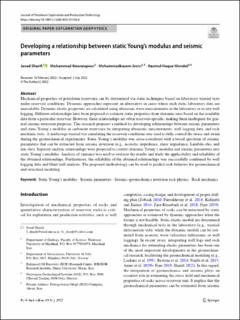Developing a relationship between static Young’s modulus and seismic parameters
Journal article
Permanent lenke
https://hdl.handle.net/11250/3064526Utgivelsesdato
2022-07-19Metadata
Vis full innførselSamlinger
- NGI articles [1061]
Sammendrag
Mechanical properties of petroleum reservoirs can be determined via static techniques based on laboratory triaxial tests
under reservoir conditions. Dynamic approaches represent an alternative in cases where such static laboratory data are
unavailable. Dynamic elastic properties are calculated using ultrasonic wave measurements in the laboratory or in situ well
logging. Different relationships have been proposed to estimate static properties from dynamic ones based on the available
data from a particular reservoir. However, these relationships are often reservoir-specific, making them inadequate for general
seismic inversion purposes. This research proposes a method for developing relationships between seismic parameters
and static Young’s modulus in carbonate reservoirs by integrating ultrasonic measurements, well logging data, and rock
mechanic tests. A multistage triaxial test simulating the reservoir conditions was used to fully control the stress and strain
during the geomechanical experiments. Static Young’s modulus was cross-correlated with a broad spectrum of seismic
parameters that can be extracted from seismic inversion (e.g., acoustic impedance, shear impedance, Lambda–rho, and
mu–rho). Separate analytic relationships were proposed to convert dynamic Young’s modulus and seismic parameters into
static Young’s modulus. Analysis of variance was used to evaluate the results and study the applicability and reliability of
the obtained relationships. Furthermore, the reliability of the obtained relationships was successfully confirmed by well
logging data and blind well analysis. The proposed methodology can be used to predict rock behavior for geomechanical
and structural modeling.
